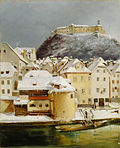This article needs additional citations for verification .(March 2008) |
Narodna galerija | |
 The main building of the National Gallery of Slovenia in Ljubljana | |
 | |
| Established | 1918 |
|---|---|
| Location | Ljubljana |
| Coordinates | 46°3′13″N14°30′0″E / 46.05361°N 14.50000°E |
| Type | art gallery |
| Website | www |
The National Gallery of Slovenia (Slovene : Narodna galerija) is the national art gallery of Slovenia. It is located in the capital Ljubljana. It was founded in 1918, after the dissolution of Austria-Hungary and the establishment of the State of Slovenes, Croats and Serbs. [1] Initially, it was hosted in the Kresija Palace of Ljubljana, but moved to the present location in 1925. [2]









